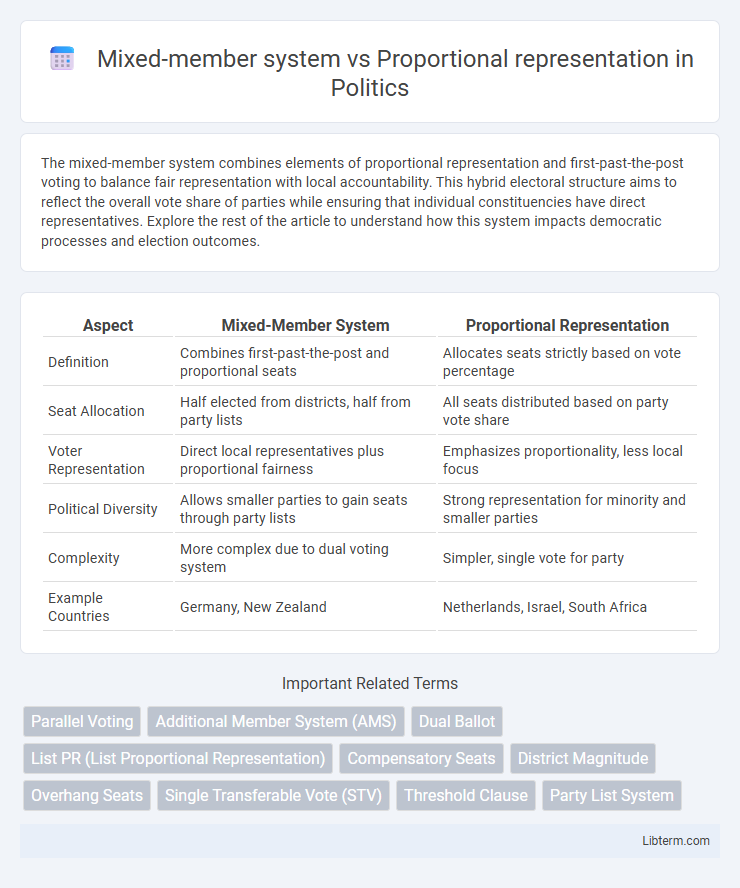The mixed-member system combines elements of proportional representation and first-past-the-post voting to balance fair representation with local accountability. This hybrid electoral structure aims to reflect the overall vote share of parties while ensuring that individual constituencies have direct representatives. Explore the rest of the article to understand how this system impacts democratic processes and election outcomes.
Table of Comparison
| Aspect | Mixed-Member System | Proportional Representation |
|---|---|---|
| Definition | Combines first-past-the-post and proportional seats | Allocates seats strictly based on vote percentage |
| Seat Allocation | Half elected from districts, half from party lists | All seats distributed based on party vote share |
| Voter Representation | Direct local representatives plus proportional fairness | Emphasizes proportionality, less local focus |
| Political Diversity | Allows smaller parties to gain seats through party lists | Strong representation for minority and smaller parties |
| Complexity | More complex due to dual voting system | Simpler, single vote for party |
| Example Countries | Germany, New Zealand | Netherlands, Israel, South Africa |
Introduction to Mixed-Member Systems
Mixed-member systems combine single-member district elections with proportional representation, aiming to balance local accountability and overall party fairness. Voters typically cast two ballots: one for a candidate in their district and another for a party list, ensuring both individual candidate selection and proportional seat allocation. This hybrid approach reduces disproportionality seen in first-past-the-post systems while maintaining direct voter-candidate connections.
Understanding Proportional Representation
Proportional representation (PR) ensures that political parties receive seats in legislature closely matching their share of the popular vote, promoting fairer representation of diverse political views. Unlike the Mixed-Member system, which combines first-past-the-post and proportional elements, PR systems often use party lists or single transferable vote methods to allocate seats. This system reduces wasted votes and strengthens smaller parties' presence, enhancing overall democratic inclusivity.
Key Features: Mixed-Member vs. Proportional Representation
The mixed-member system combines single-member district elections with proportional representation to balance local representation and overall party proportionality. Proportional representation allocates seats strictly according to the percentage of votes each party receives, ensuring a closely aligned reflection of voter preferences. Mixed-member systems often include a compensatory mechanism to correct disproportional outcomes from district elections, enhancing fairness in legislative composition.
Electoral Process Compared
The mixed-member system combines single-member district elections with proportional representation to balance constituency representation and overall party vote share, often using two votes for voters: one for a candidate and another for a party list. Proportional representation systems allocate seats solely based on the percentage of votes each party receives, ensuring a close match between vote share and legislative seats without direct candidate elections in specific districts. The electoral process in mixed-member systems typically involves both direct candidate elections and party list allocations, whereas pure proportional systems rely exclusively on party lists and vote totals to determine seat distribution.
Representation of Voters’ Preferences
The Mixed-member system combines single-member district winners with party-list seats to balance individual candidate appeal and overall party proportionality, enhancing voter preference representation. Proportional representation allocates seats strictly according to the percentage of votes each party receives, ensuring that even smaller parties gain legislative presence reflective of their support. Both systems aim to represent voters' preferences but differ in balancing local accountability with proportional fairness.
Impact on Political Parties
The mixed-member system combines single-member district elections with proportional representation, allowing political parties to gain legislative seats both through direct local contests and overall vote share, often benefiting larger parties while maintaining representation for smaller ones. Proportional representation focuses solely on allocating seats based on the percentage of votes received, fostering multiparty systems by enabling smaller parties to secure representation more consistently. This system encourages coalition governments and increases political party diversity, contrasting with the mixed-member system's balance between local accountability and proportionate party representation.
Government Stability and Coalition Formation
The Mixed-member system balances direct constituency representation with proportional party lists, often leading to more stable governments compared to pure Proportional Representation, which can result in fragmented parliaments and frequent coalition negotiations. Coalition formation under the Mixed-member system tends to be more predictable as larger parties secure constituency seats, reducing the number of smaller parties required to form a government. In contrast, Proportional Representation encourages multi-party systems where coalition governments are common, sometimes causing instability due to diverse political interests and prolonged coalition agreements.
Regional vs. National Interests
Mixed-member systems balance regional and national interests by combining single-member districts with party-list proportional representation, ensuring local constituencies have direct representation while reflecting broader party support. Proportional representation prioritizes national party vote shares, promoting overall fairness in translating votes to seats but sometimes at the expense of local accountability. The mixed-member approach integrates constituency focus with proportional fairness, aligning regional representation with national political dynamics.
Advantages and Disadvantages of Each System
The Mixed-member system combines single-member district elections with proportional representation, providing a balance between local accountability and overall proportional fairness, but it can lead to complexity and potential overhang seats that complicate government formation. Proportional representation offers a more accurate reflection of voters' preferences by allocating seats based on the percentage of votes received, promoting multiparty inclusiveness, though it may result in fragmented legislatures and unstable coalition governments. Each system affects party dynamics, voter engagement, and the degree to which legislative bodies mirror society's political diversity, influencing governance effectiveness.
Which System is Best?
The mixed-member system combines single-member districts with proportional representation to balance local accountability and overall fairness in seat allocation, often leading to more stable governments. Proportional representation ensures that parties receive seats closely matching their share of the vote, enhancing diversity and reducing wasted votes but sometimes resulting in fragmented parliaments. Which system is best depends on priorities like governance stability, voter representation, and political pluralism, with mixed-member systems favored in countries like Germany and New Zealand, while pure proportional systems are common in nations such as Sweden and the Netherlands.
Mixed-member system Infographic

 libterm.com
libterm.com